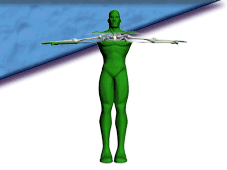P.I.N.S. Explained:
Percutaneous Iontophoretic Needle Stimulation (PINS)
COMBINED CARE CENTER, P.C.Dan M. Young, D.C., D.N., D.A.B.C.O.
Diplomate of the American Board of Chiropractic Orthopedics
283 Peterson Rd., Libertyville, Il. 60048 847-367-1770
What is percutaneous iontophoretic needle stimulation (PINS)?
PINS therapy, or PINS Prolotherapy, is a minimally painful procedure. The treatment takes advantage of the electrical conductivity of acupuncture needles that are aimed in the direction of the patient’s chronic pain. The current is a one-way stream of ions that creates a small irritation to the tissues thus bringing tissue growth cells to the area for healing that would, otherwise, not take place. An electrically conductive substance that further promotes a healing reaction is added to the needles with the aim of causing it to be absorbed into the surrounding deep tissue. This type of substance penetration requires a special type of DIRECT CURRENT. The (covalent) bonding of the substance with the direct current to achieve deep tissue penetration is called IONTOPHORESIS. The acupuncture needles are inserted deeper into the body than normal acupuncture insertions, making them PERCUTANEOUS.
How does the iontophoresis work to improve my chronic pain?
The overall effect of PINS therapy is chemotaxis, the pulling of mobile cells, in this case healing blood cells, to an area of relatively lower concentration, in this case the chronic pain site. The PINS Prolotherapy acts like a magnet to draw healing cells to the area. Our blood and related system continually carries and produces regenerative cells. It has the ability to create new tissue where our old tissues have been damaged.
Why doesn’t my body heal itself without the PINS therapy?
Over time our bodies tend to lose the ability to supply our damaged tissues with healing cells. The cells we are talking about are called Fibroblasts and they produce the main connective tissue building block, collagen. Many researchers have produced a long list of reasons why this healing deficiency occurs. Here are some of the reasons:
- Poor circulation - due to injury, disease, or age
- Poor nutrition - for example, a diet deficient in zinc will cause reduced collagen synthesisM
- Drugs - especially anti-inflammatories suppress multiplication of fibroblasts
- Age - cell replication is just slower
- Immune response - the body could be busy producing healing for allergies and the like
- Obesity - adipose tissue has poor vascularity
- Stress - this causes high levels of glucocorticoids that suppress immunity and healing
- Bacteria and other invaders - these reduce the body’s ability to heal
- Dehydration - healing has been shown to occur more rapidly in the presence of moisture
- Cold or hot conditions - The optimum temperature for healing is 37 Celsius (98.6F)
- Mechanical disturbances - disturbing the wound can disrupt the new granular tissue
- Previous surgery - can produce scar tissue that reduces blood flow to an area
- Overall health loss - reduces the general ability to heal
Return to the PINS Page Page
Return to the Where's Your Pain? Page



